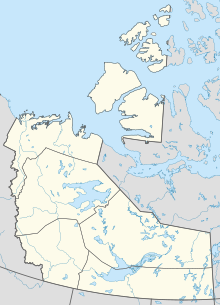Ekati Diamond Mine
 Ekati mine aerial view, August 2010. Four open pits on four kimberlite pipes may be seen, along with the Ekati airport. | |
| Location | |
|---|---|
 Ekati Diamond Mine Location in Canada | |
| Location | Lac de Gras |
| Territory | Northwest Territories |
| Country | Canada |
| Coordinates | 64°42′49″N 110°37′10″W / 64.71361°N 110.61944°WCoordinates: 64°42′49″N 110°37′10″W / 64.71361°N 110.61944°W |
| Production | |
| Products | Diamonds |
| History | |
| Discovered | 1991 |
| Opened | 1998 |
| Owner | |
| Company | Dominion Diamond Mines (90%), Stewart Blusson (10%) |
| Website | www.ddcorp.ca |

The Ekati Diamond Mine ("Ekati") is Canada's first surface and underground diamond mine.[1] It is located 310 km (190 mi) north-east of Yellowknife,[2] Northwest Territories, and about 200 km (120 mi) south of the Arctic Circle, near Lac de Gras. Until 2014 Ekati was a joint venture between Dominion Diamond Mines (80%), and the two geologists who discovered kimberlite pipes north of Lac de Gras, Chuck Fipke and Stewart Blusson each holding a 10% stake in the mine, until Fipke sold his share to Dominion.[3][1]
History[]
The first volcanic pipe found in the Lac de Gras region was the Point Lake kimberlite,[4] discovered by Chuck Fipke and Stewart Blusson who had been prospecting in the region for almost ten years, having found kimberlite indicator minerals as early as 1985.[1] The Point Lake kimberlite was determined to be uneconomic, but its discovery precipitated one of largest staking rushes in mining history, covering most of the area between Yellowknife and the Arctic coast.[5] There are 156 known kimberlite pipes within the Ekati block of claims, including the Point Lake pipe. Ekati officially began operations on October 14, 1998, and was operated by BHP Billiton Canada Inc., a part of the BHP Billiton Group, the world's largest diversified resources company.
The next kimberlites to be developed at Ekati will be mined using open pit methods and are named Jay and Sable, discovered in 1993 and 1995, respectively. Underground mining of the Misery kimberlite will commence in 2020, after open pit operations have been completed. Ekati Diamond mine, which is currently operated by Dominion Diamond is scheduled to remain operational until 2033.[6]
On November 13, 2012, CBC reported that the Harry Winston Diamond Corporation (now: Dominion Diamond Mines), 40% owners of Diavik Diamond Mine, would buy Ekati for US$500 million.[2]
Geology[]
Diamonds at the Ekati site are found in 45- to 62-million-year-old kimberlite pipes (Creaser et al., 2004) of the Lac de Gras kimberlite field, most of which lie underneath shallow lakes.
Mining and marketing[]
Between 1998 and 2009, the mine has produced 40 million carats (8,000 kg or 17,637 lb) of diamonds out of six open pits.[1] As the high grade ore close to surface was depleted, development was completed to access the ore utilizing underground methods. Currently, there is one underground operation (Koala) with open-cut mining occurring in Fox Pit.[1] The mine's current annual production is estimated to be approximately 7.5 million carats (1,500 kg or 3,307 lb) of diamonds.[7]
Ekati supplies rough diamonds to the global market through its sorting and selling operations in Canada, Belgium, and India.[8]
Transportation[]
Mine workers fly-in fly-out through Ekati Airport.
See also[]
- Hugo Dummett of BHP, credited as co-discoverer of Ekati
- Volcanism of Canada
- Volcanism of Northern Canada
- Ekati Airport
Footnotes[]
- ^ Jump up to: a b c d e Zlotnikoc, Dan (November 2008). "A norther star - Canada's first diamond mine celebrates a milestone". CIM Magazine. Montreal, Quebec, Canada: CIM Magazine. 3 (7): 40–43. ISSN 1718-4177.
- ^ Jump up to: a b Harry Winston buying Ekati mine for $500M US
- ^ Koven, Peter. "Life after Ekati: Legendary Canadian geologist Chuck Fipke gears up for more exploration". Financial Post. Retrieved 19 November 2016.
- ^ Erlich, E., Dan Hausel, W. (2002) Diamond deposits: origin, exploration, and history of discovery. Society for Mining, Metallurgy, and Exploration, Inc. (SME), Littleton, CO.
- ^ The Northern Miner 1998 "Mining Man of the Year" award to Hugo Dummett
- ^ Ekati Diamond Mine Archived 2013-05-12 at the Wayback Machine at Dominion Diamond
- ^ Zimnisky, Paul (January 22, 2013). "The state of 2013 global rough diamond supply". Resource Investor. Archived from the original on January 28, 2013. Retrieved February 4, 2013.
- ^ "About Us". Retrieved 2013-08-09.
References[]
- Creaser, R.A. et al., 2004. "Macrocrystal phlogopite Rb-Sr dates for the Ekati property kimberlites, Slave Province, Canada: evidence for multiple intrusive episodes in the Paleocene and Eocene", 8th International Kimberlite Conference Selected Papers, vol. 1, pp. 399–414.
- Abraham, Carolyn, October 11, 2006. "X marks the spotlight for elusive benefactor", The Globe and Mail.
- Stuart Blusson from the GSC to Ekati
- "EKATI Diamond Mine 2009 Year in Review" (PDF). BHP Billiton Canada Inc. 2009. Retrieved 2010-06-04.]
Further reading[]
- Kevin Krajick, Barren Lands: An Epic Search for Diamonds in the North American Arctic. 2001, Freeman/Henry Holt, ISBN 0-7167-4026-5. Review at Smithsonian Magazine
- Chapter 17. Diamond Exploration – Ekati and Diavik Mines, Canada by Charles J. Moon (Google Books preview )in Charles J. Moon, M. K. G. Whateley, Anthony M. Evans, Introduction to Mineral Exploration, 2nd Edition. 2006,Wiley-Blackwell. ISBN 978-1-4051-1317-5.
- Figures and captions from Chapter 17 are available at publisher's site
External links[]
- Official website by the current operators, Dominion Diamond Mines. Includes a photo of the largest diamond yet found, a 186 ct. water-white gem found in 2016.
- Ekati Diamond Mine photos at Google Images
- Ekati Diamond Mine profile at BHP Billiton Watch
- CanadaMark+
- Diamond mines in Canada
- Mines in the Northwest Territories
- Diatremes of the Northwest Territories
- Paleocene volcanoes
- Eocene volcanoes
- Surface mines in Canada
- Underground mines in Canada
- Buildings and structures completed in 1998
- 1998 establishments in the Northwest Territories

